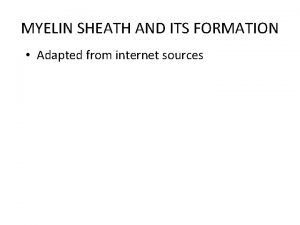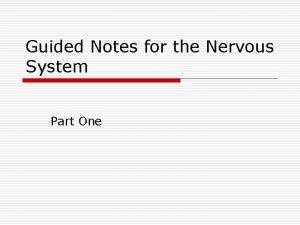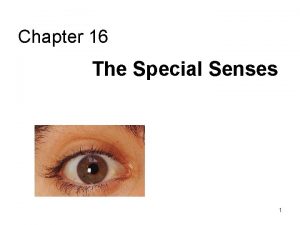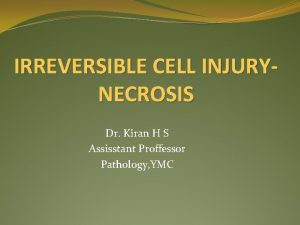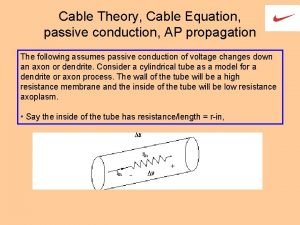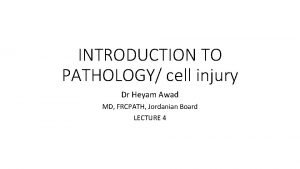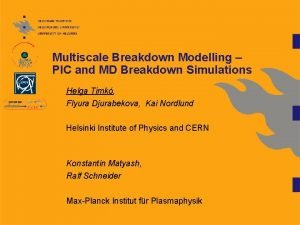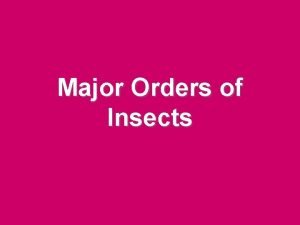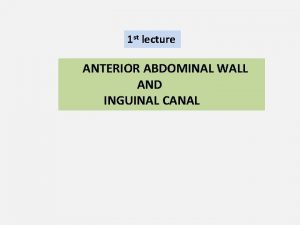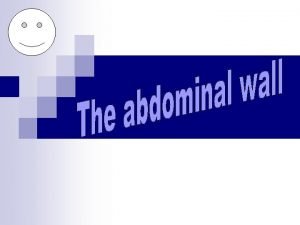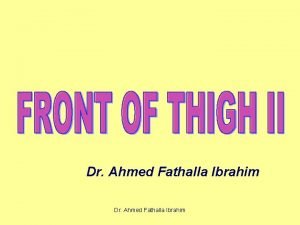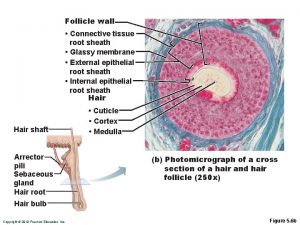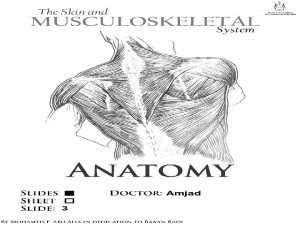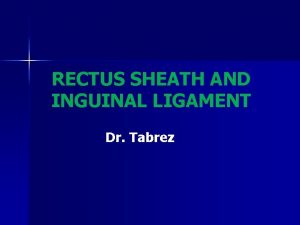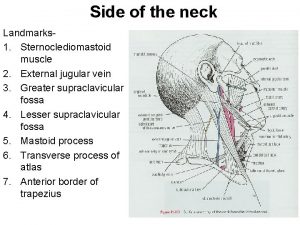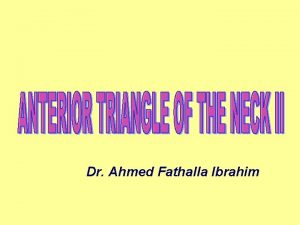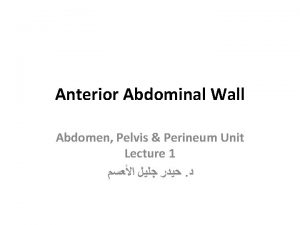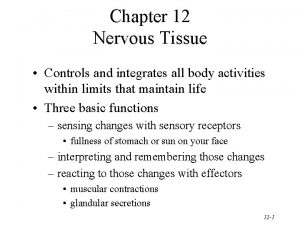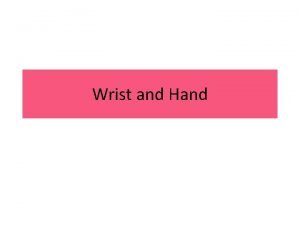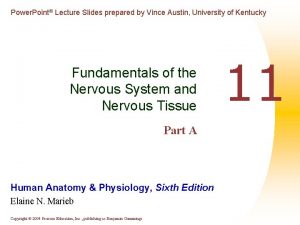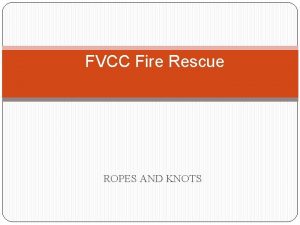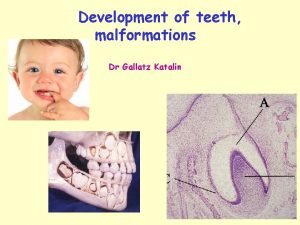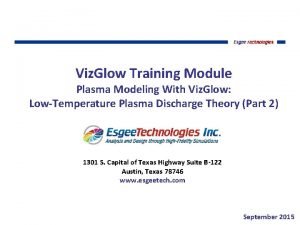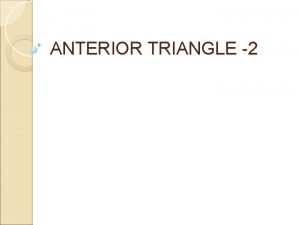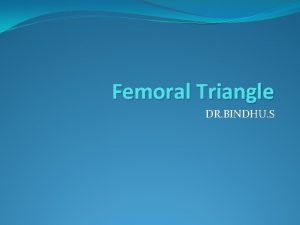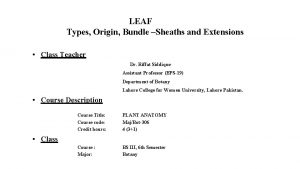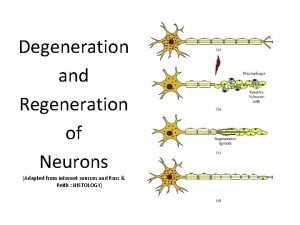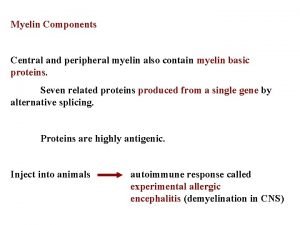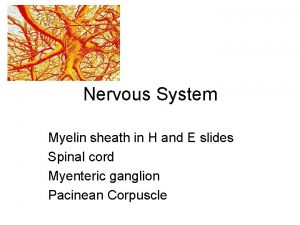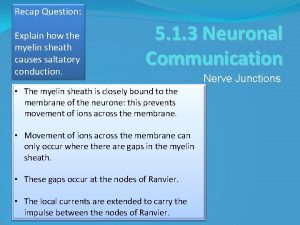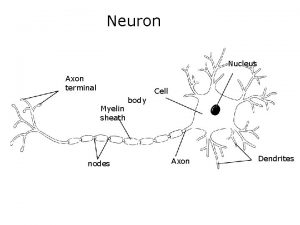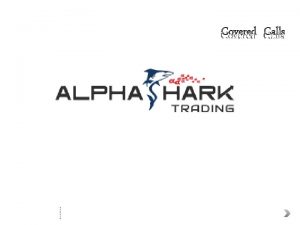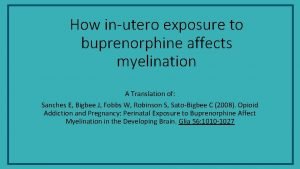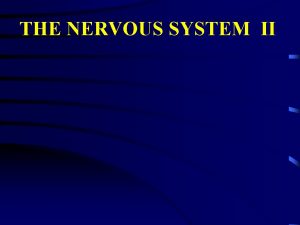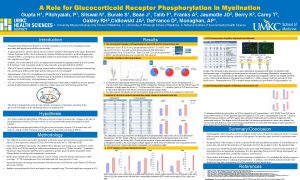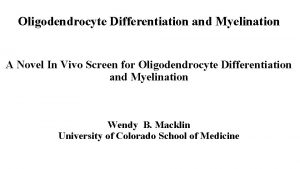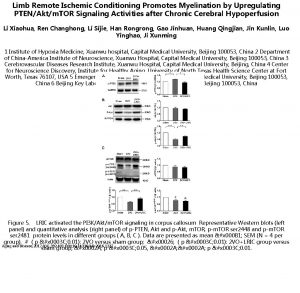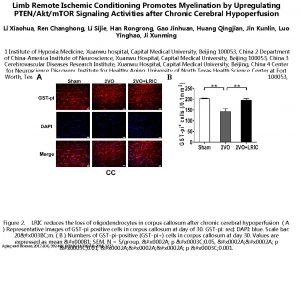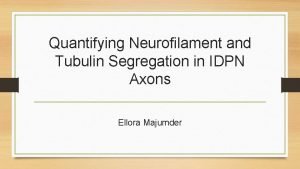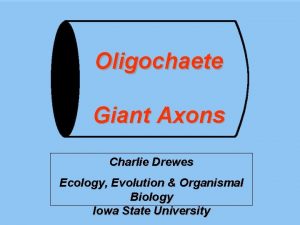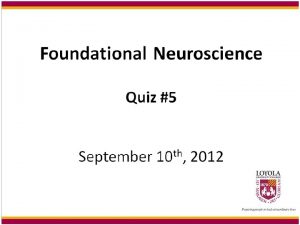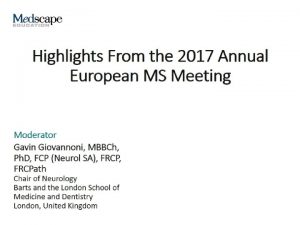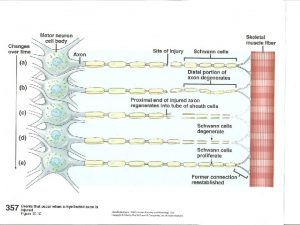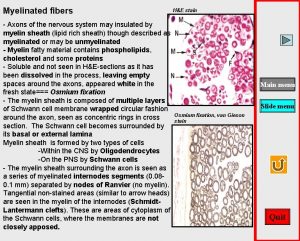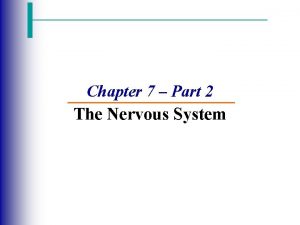Myelination n Axons covered with a myelin sheath
































- Slides: 32

Myelination n Axons covered with a myelin sheath q q q n Nodes of R? ? : gaps in the myelin q n Many layers of lipid and protein: in? ? ? neurons How does it impact nerve conduction? Appears what color? Nodes are important for rapid signal conduction Some diseases destroy myelin: q q ? ? ? Copyright 2010, John Wiley & Sons, Inc.

Myelination n Axons covered with a myelin sheath q q q n Nodes of Ranvier: gaps in the myelin q n Many layers of lipid and protein: insulates neurons Increases speed of nerve conduction Appears white (in white matter) Nodes are important for rapid signal conduction Some diseases destroy myelin: q q Multiple sclerosis Tay-Sachs Copyright 2010, John Wiley & Sons, Inc.

Collections of Nervous Tissue n Clusters of neuron cell bodies q q n Ganglion: cluster of cell bodies in PNS Nucleus: cluster of cell bodies in CNS Bundles of axons q q N? ? : bundle of axons in PNS T? ? ? t: bundle to axons in CNS Copyright 2010, John Wiley & Sons, Inc.

Collections of Nervous Tissue n Clusters of neuron cell bodies q q n Ganglion: cluster of cell bodies in PNS Nucleus: cluster of cell bodies in CNS Bundles of axons q q Nerve: bundle of axons in PNS Tract: bundle to axons in CNS Copyright 2010, John Wiley & Sons, Inc.

Gray and White Matter n n n White matter: primarily myelinated axons Gray matter: cell bodies, dendrites, unmyelinated axons, axon terminals, neuroglia Locations of gray and white matter q q Spinal cord: white matter (tracts) surround centrally located gray matter “H” of “butterfly” Brain: gray matter in thin cortex surrounds white matter (tracts) Copyright 2010, John Wiley & Sons, Inc.

Gray and White Matter n n n 1 -? ? matter: primarily myelinated axons 2 -? ? matter: cell bodies, dendrites, unmyelinated axons, axon terminals, neuroglia Locations of gray and white matter q q Spinal cord: white matter (tracts) surround centrally located gray matter “H” of “butterfly” Brain: gray matter in thin cortex surrounds white matter (tracts) Copyright 2010, John Wiley & Sons, Inc.

Grey & White matter

Neuron Regeneration n n Regeneration of PNS neurons q Axons and dendrite in the PNS can be repaired if Regeneration of CNS neurons q Very limited even if cell body is intact q Inhibited by neuroglia and by lack of fetal growthstimulators “Unique cells in neuronal tissues, called olfactory ensheathing glia (OEG) cells, have been reported to be the only nerve cells of the CNS capable of constant regeneration; They have successfully been used to partially recover the locomoter activity in dogs paralyzed due to traumatic spinal cord injury!" Copyright 2010, John Wiley & Sons, Inc.

Neuron Regeneration n n Regeneration of PNS neurons q Axons and dendrite in the PNS can be repaired if cell body is intact and Schwann cells functional. These form a regeneration tube and grow axons or dendrites if scar tissue does not fill the tube Regeneration of CNS neurons q Very limited even if cell body is intact q Inhibited by neuroglia and by lack of fetal growthstimulators “Unique cells in neuronal tissues, called olfactory ensheathing glia (OEG) cells, have been reported to be the only nerve cells of the CNS capable of constant regeneration; They have successfully been used to partially recover the locomoter activity in dogs paralyzed due to traumatic spinal cord injury!" Copyright 2010, John Wiley & Sons, Inc.

Organization of the Nervous System n Central nervous system (CNS) structures: q q n B? S? Peripheral nervous system (PNS) structures: q q C? nerves and branches S? nerves and branches Ganglia S? ? ? receptors Copyright 2010, John Wiley & Sons, Inc.

Organization of the Nervous System n Central nervous system (CNS) structures: q q n Brain Spinal cord Peripheral nervous system (PNS) structures: q q Cranial nerves and branches Spinal nerves and branches Ganglia Sensory receptors Copyright 2010, John Wiley & Sons, Inc.

Organization of the Nervous System 1 -? 2 -? Copyright 2010, John Wiley & Sons, Inc.

Organization of the Nervous System Copyright 2010, John Wiley & Sons, Inc.

Organization of the Nervous System n Peripheral nervous system (PNS) divisions q Somatic (SNS) n n q Sensory neurons from head, body wall, limbs, special sense organs Motor neurons to skeletal muscle: voluntary Autonomic (ANS) nervous systems n n Sensory neurons from viscera Motor neurons to viscera (cardiac muscle, smooth muscle, glands): involuntary 1 -? ? ? : “fight-or-flight” q 2 -? ? ? : “rest-and-digest” q Copyright 2010, John Wiley & Sons, Inc.

Organization of the Nervous System n Peripheral nervous system (PNS) divisions q Somatic (SNS) n n q Sensory neurons from head, body wall, limbs, special sense organs Motor neurons to skeletal muscle: voluntary Autonomic (ANS) nervous systems n n Sensory neurons from viscera Motor neurons to viscera (cardiac muscle, smooth muscle, glands): involuntary Sympathetic: “fight-or-flight” q Parasympathetic: “rest-and-digest” q Copyright 2010, John Wiley & Sons, Inc.

Structure and Function of the Nervous System Interactions Animation n Introduction to Structure and Function of the Nervous System You must be connected to the internet to run this animation. Copyright 2010, John Wiley & Sons, Inc.

Action Potentials n n Action potentials = n? i? Require q q A membrane potential: a charge difference across cell membrane (polarization) Ion channels: allow ions to move by diffusion from high to low concentration n n Leakage channels: allow ions to leak through membrane; there are more for K+ than for Na+ Gated channels Open and close on command q Respond to changes in membrane so can generate and conduct action potentials q Copyright 2010, John Wiley & Sons, Inc.

Action Potentials n n Action potentials = nerve impulses Require q q A membrane potential: a charge difference across cell membrane (polarization) Ion channels: allow ions to move by diffusion from high to low concentration n n Leakage channels: allow ions to leak through membrane; there are more for K+ than for Na+ Gated channels Open and close on command q Respond to changes in membrane so can generate and conduct action potentials q Copyright 2010, John Wiley & Sons, Inc.

Conduction of Nerve Impulses n Nerve impulse conduction (propagation) q n Each section triggers the next locally as even more Na+ channels are opened (like row of dominos) Types of conduction q Continuous conduction n q ? ? ? ? ? conduction n n In unmyelinated fibers; slower form of conduction In myelinated fibers; faster as impulses “leap” between nodes of Ranvier Factors that increase rate of conduction q Myelin, large diameter and warm nerve fibers Copyright 2010, John Wiley & Sons, Inc.

Conduction of Nerve Impulses n Nerve impulse conduction (propagation) q n Each section triggers the next locally as even more Na+ channels are opened (like row of dominos) Types of conduction q Continuous conduction n q Saltatory conduction n n In unmyelinated fibers; slower form of conduction In myelinated fibers; faster as impulses “leap” between nodes of Ranvier Factors that increase rate of conduction q Myelin, large diameter and warm nerve fibers Copyright 2010, John Wiley & Sons, Inc.

Synaptic Transmission n Similar sequence of events occurs at q q q n n Synapse (neuron-neuron) Neuromuscular junction (neuron-muscle fiber) Neuroglandular junction (neuron-gland) Triggered by action potential (nerve impulse) Components of synapse: q q q Sending neuron: presynaptic neuron (releases neurotransmitter) Space between neurons: synaptic cleft Receiving neuron: postsynaptic neuron Copyright 2010, John Wiley & Sons, Inc.

Synaptic Transmission n ? ? ? -way transmission only because q q n Only presynaptic cells release NT Only postsynaptic cells have receptors for NT binding Finally, NT must be removed from the cleft. Three possible mechanisms q q q Diffusion out of cleft Destruction by enzymes (such as ACh-ase) in cleft Transport back (recycling) into presynaptic cell Copyright 2010, John Wiley & Sons, Inc.

Synaptic Transmission n One-way transmission only because q q n Only presynaptic cells release NT Only postsynaptic cells have receptors for NT binding Finally, NT must be removed from the cleft. Three possible mechanisms q q q Diffusion out of cleft Destruction by enzymes (such as ACh-ase) in cleft Transport back (recycling) into presynaptic cell Copyright 2010, John Wiley & Sons, Inc.

Signal Transmission at the Chemical Synapse Copyright 2010, 2009 John. Wiley&&Sons, Inc. 24

Diversity of Neurotransmitters n n n About 100 substances that are either known or suspected neurotransmitters have been identified in the human body. Many neurotransmitters are amino acids or derivatives thereof. Some neurotransmitter are activating by depolarizing the post synaptic cell; they are excitatory Other neurotransmitter are inhibiting by hyperpolarizing the post synaptic cell; they are inhibitory Many important drugs are interfering with the biological function of neurotransmitters in the CNS

Neurotransmitters n Acetylcholine (ACh): common in PNS q q n Amino acids q n n Glutamate, aspartate, gamma aminobutyric acid (GABA), glycine Modified amino acids q n Stimulatory (on skeletal muscles) Inhibitory (on cardiac muscle) Norepinephrine (NE), dopamine (DA), serotonin Neuropeptides such as endorphins Nitric oxide (NO) Copyright 2010, John Wiley & Sons, Inc.

Neurotransmitter inhibitors Neurotransmitter Acetylcholine (ACh) Mode of action excitatory/inhibitory - via either muscarinic (m) or nicotinic (n) receptors Interfering drugs / effects / disorders Inhibitors Curare (- ACh. R) --> at NMJ, Botox & local anesthetics (-) --> ACh release Atropin (- ACh. R) --> parasympaticus Parasympatomimetics Muscarin (+ ACh. R) --> parasympaticus Nicotine (+ ACh. R) --> vegetative ganglia & NMJ Carbachol (+) --> ACh mimetic Pilocarpin (+) --> ACh mimetic Norepinephrine (Nor) excitatory Isoprotenerol (+) -stimulate the α 1, α 2, β 1 and β 2 Propranolol (-) --> beta-receptors (heart) Adrenaline (Adr) adrenoceptors; Phentolamine (-) --> alpha-receptors (blood vessels) Glutamate excitatory (NMDA-Receptor) Aspartate excitatory gamma amino butyric acid (GABA)inhibitory Diazepam ("Valium") (+) Glycine inhibitory Dopamin (DA) excitatory Cocaine (+) - inhib. of reuptake Zyprexa (-) - inhib. of DA receptor binding Schizophrenia (excess DA) Chlorpromazine (-) Endorphins, Enkephalins excitatory Acupuncture (+) - stim. of analgesia Euphoria - "Runner's high" effect Serotonin excitatory Imipramine (+) Fluoxetine (+) - selective serotonin re- uptake inhibitors (SSRIs) Sertraline (+) Nitric oxide (NO) excitatory (local neurotransmitter)

1 -Name this condition = progressive, inflammatory disease of the CNS; caused by the entering of white blood cells into the brain and their subsequent destruction of the axon-surrounding myelin sheaths; more prevalent in females than in males; affects about 2 million people worldwide; cause is unknown, but there seems to be a connection to previous viral infection of the CNS, e. g. by the herpes virus; 2 -Name this chemical? ? ? = popular synthetic insect repellent, which is used by an estimated 200 million people worldwide; according to a recent study it is suspected to cause CNS damaeg the same way as some insecticides and nerve gases, e. g. sarin, do. Acetylcholinesterase enzyme inhibitor.

Multiple sclerosis (MS) = progressive, inflammatory disease of the CNS; caused by the entering of white blood cells into the brain and their subsequent destruction of the axon-surrounding myelin sheaths; more prevalent in females than in males; affects about 2 million people worldwide; cause is unknown, but there seems to be a connection to previous viral infection of the CNS, e. g. by the herpes virus; DEET = popular synthetic insect repellent, which is used by an estimated 200 million people worldwide; according to a recent study it is suspected to cause CNS damaeg the same way as some insecticides and nerve gases, e. g. sarin, do. Acetylcholinesterase enzyme inhibitor.

SSRI = selective serotonin re-uptake inhibitors; molecules, such as fluoxetine (----? ) or sertaline that selectively block the re-uptake of the excitatory neurotransmitter serotonin from the synaptic gap; they block the binding of serotonin to the serotonin transporter; commonly administered to patients for treatment of depression and other mood disorders Name this The most commonly used anti-depressant in (fluoxetine) the U. S. ; class of SSRIs which targets the transporter protein (5 -HTT) of the neurotransmitter serotonin in brain; in presence of tnhe drug, the excitatory neuro- transmitter serotonin remains longer in synaptic gap

SSRI = selective serotonin re-uptake inhibitors; molecules, such as fluoxetine (Prozac) or sertaline that selectively block the re-uptake of the excitatory neurotransmitter serotonin from the synaptic gap; they block the binding of serotonin to the serotonin transporter; commonly administered to patients for treatment of depression and other mood disorders Prozac The most commonly used anti-depressant in (fluoxetine) the U. S. ; class of SSRIs which targets the transporter protein (5 -HTT) of the neurotransmitter serotonin in brain; in presence of Prozac, the excitatory neuro- transmitter serotonin remains longer in synaptic gap

NMDA ("Ecstasy") = Synthetic acetoamphetamine derivative; transient euphoria-triggering, illegal "fashion drug", which strongly affects the serotonin system of the CNS; leads to serotonin increase in the synaptic gaps due to interfering with the serotonin transporter/ 5 -HTT uptake system; Ecstasy & Toxicology “Animal studies strongly suggest that NMDA inflicts lasting damage to the brain's serotonin system. According to an UK long-term effect study, people who took ecstasy performed worse on mental performance tests, e. g. memory, attention, planning, showed deficiencies in verbal and working memory tests, showed signs of depression and a weakened immune system. ”
 Neuron structure
Neuron structure Myelin sheath
Myelin sheath Nervous system guided notes
Nervous system guided notes Retina and optic nerve
Retina and optic nerve Necrosis
Necrosis Types of synapse
Types of synapse Cable theory equation
Cable theory equation Myelin figures in reversible cell injury
Myelin figures in reversible cell injury Cern
Cern Sheath-winged
Sheath-winged Hesselbach triangle boundaries
Hesselbach triangle boundaries Hernia en glissade
Hernia en glissade Termination of femoral artery
Termination of femoral artery Dermal papilla
Dermal papilla Descending hypoglossi
Descending hypoglossi Femoral sheath
Femoral sheath Pelvifemoral space
Pelvifemoral space Carotid sheath contents
Carotid sheath contents Carotid triangle contents
Carotid triangle contents Rectus sheath
Rectus sheath Spatial summation
Spatial summation Flexor digitorum superficialis
Flexor digitorum superficialis Neurilemmal sheath
Neurilemmal sheath Double sheet bend
Double sheet bend Ectomesenchyme
Ectomesenchyme Outer covering definition
Outer covering definition Vizglow
Vizglow Triangle
Triangle Sven ivar seldinger
Sven ivar seldinger Femoral ring
Femoral ring Bundle sheath extension function
Bundle sheath extension function Neuron sheath
Neuron sheath Concept covered answer key
Concept covered answer key

